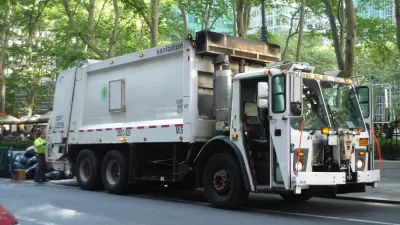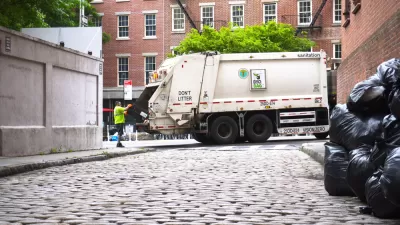The NYC Sanitation Department's budget has tripled over the past 17 years, despite Mayor Bloomberg's waste management reforms. With recycling rates dismally low and a long-range management plan stalled, Bill de Blasio will have to clean up the mess.
To stabilize the rising costs of New York City's waste management, Mayor Michael Bloomberg undertook two key reforms. First, he suspended plastic and glass recycling when he entered office. "The recycling rate — meaning, the percentage of material kept out of landfills — was 20 percent before the cuts," reports Amy Eddings. "In 2005, a year after they were restored, it was 16.8, according to the Mayor's Management Report for Fiscal Year 2005. It's never been higher than that. If you add the collection of old electronics, motor oil and yard waste, New York City's overall recycling rate is about 27 percent. By comparison, San Francisco's recycling rate is around 77 percent, Los Angeles, about 62 percent, and Seattle about 51 percent."
In 2006, the Mayor pushed through the second key reform - a controversial Solid Waste Management Plan (SWMP). But, as Eddings explains, "The SWMP has become a swamp, mired in litigation and politics. Just one of the seven facilities the city was supposed to build is operating."
With recycling rates dismally low and implementation of the SWMP stalled, "Mayor Michael Bloomberg is leaving the incoming administration of Bill de Blasio with a pile of unfinished business."
FULL STORY: Bloomberg and Garbage: A Pile of Unfinished Business

Planetizen Federal Action Tracker
A weekly monitor of how Trump’s orders and actions are impacting planners and planning in America.

San Francisco's School District Spent $105M To Build Affordable Housing for Teachers — And That's Just the Beginning
SFUSD joins a growing list of school districts using their land holdings to address housing affordability challenges faced by their own employees.

The Tiny, Adorable $7,000 Car Turning Japan Onto EVs
The single seat Mibot charges from a regular plug as quickly as an iPad, and is about half the price of an average EV.

Trump Approves Futuristic Automated Texas-Mexico Cargo Corridor
The project could remove tens of thousands of commercial trucks from roadways.

Austin's First Single Stair Apartment Building is Officially Underway
Eliminating the requirement for two staircases in multi-story residential buildings lets developers use smaller lots and more flexible designs to create denser housing.

Atlanta Bus System Redesign Will Nearly Triple Access
MARTA's Next Gen Bus Network will retool over 100 bus routes, expand frequent service.
Urban Design for Planners 1: Software Tools
This six-course series explores essential urban design concepts using open source software and equips planners with the tools they need to participate fully in the urban design process.
Planning for Universal Design
Learn the tools for implementing Universal Design in planning regulations.
Smith Gee Studio
City of Charlotte
City of Camden Redevelopment Agency
City of Astoria
Transportation Research & Education Center (TREC) at Portland State University
US High Speed Rail Association
City of Camden Redevelopment Agency
Municipality of Princeton (NJ)





























